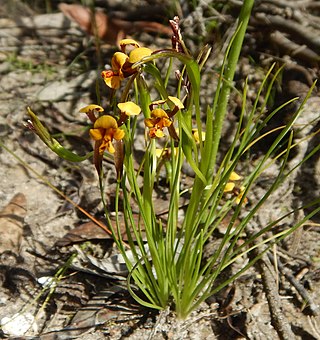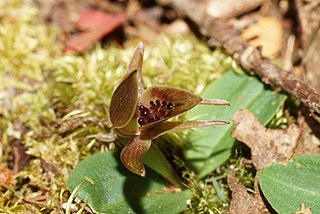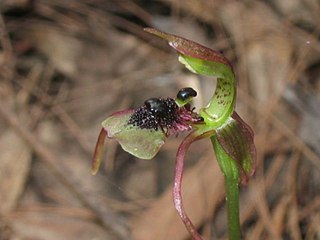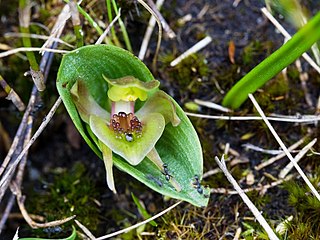
Leptoceras menziesii, commonly known as rabbit orchid, is a plant in the orchid family, Orchidaceae and the only member of the genus Leptoceras. It is a slender plant, usually found in large colonies and which only flowers after fire. The flowers are small, white, pink and red on a stem up to 30 cm (10 in) tall and is endemic to southern Australia. It was one of the first orchids from Western Australia to be described and was given the name Caladenia menziesii, a name still used by some authorities.

Diuris pardina, commonly known as the leopard orchid or leopard doubletail is a species of orchid which is endemic to south-eastern Australia. It has two or three grass-like leaves and up to ten yellow flowers with reddish-brown marks and blotches.

Caladenia angustata, commonly known as white caps, is a species of orchid endemic to Tasmania. It has a single, hairy leaf and one or two white to pinkish flowers which are reddish or greenish on their backs.

Burnettia cuneata, commonly known as the lizard orchid, is the only species of the flowering plant genus Burnettia in the orchid family, Orchidaceae. It is a leafless terrestrial, mycotrophic herb with one or two leaf-like bracts and up to seven flowers that are brownish on the back and pink or white inside. It is endemic to southeastern Australia where it grows in dense thickets in swamps.

Caladenia clavigera, commonly known as plain-lip spider orchid or clubbed spider orchid is a plant in the orchid family Orchidaceae and is endemic to Australia. It is a ground orchid which grows as scattered individuals or in small colonies in Victoria, New South Wales and South Australia. It has a single leaf and one or two small yellowish-green and red flowers.
Prasophyllum truncatum, commonly known as the truncate leek orchid, is a species of orchid endemic to Tasmania. It has a single tubular, dark green leaf and up to twenty whitish flowers with purplish and greenish-brown markings. It is a late-flowering leek orchid and its flowering is stimulated by earlier fire.

Diuris palustris, commonly known as the swamp doubletail or swamp diuris is a species of orchid which is endemic to south-eastern Australia. It has a tuft of between eight and ten twisted leaves and up to four yellow flowers with brown spots and blotches marks and blotches.

Chiloglottis cornuta, commonly known as the green bird orchid, is a species of orchid found in south-eastern Australia and in New Zealand, including many of its offshore islands. It has two broad leaves and a single green or pinkish flower with six to eight rounded, flattened green, reddish or blackish calli on the labellum.

Chiloglottis grammata, commonly known as the small bird orchid, is a species of orchid endemic to Tasmania. It has two broad leaves and a single greenish purple to purple flower with short, shiny greenish to reddish or black calli and low ridges resembling writing, covering most of the upper surface of the labellum. It is widespread and common in high rainfall mountainous areas.

Chiloglottis jeanesii, commonly known as the mountain bird orchid, is a species of orchid endemic to Victoria. It has two broad leaves and a single green to dark purplish brown flower with shiny black, column-like calli on the labellum.
Chiloglottis × pescottiana, commonly known as the bronze bird orchid, is a species of orchid endemic to south-eastern Australia. It has two broad leaves and a single greenish bronze or purplish brown flower with a black, ant-like callus on the labellum. It is a natural hybrid formed from a cross between Chiloglottis valida and C. trapeziformis.
Chiloglottis pluricallata, commonly known as the clustered bird orchid, is a species of orchid endemic to the New England Tableland and Barrington Tops in New South Wales. It has two broad leaves and a single reddish to purplish brown flower with a callus of about six pairs of reddish to blackish glands covering two-thirds of the top of the labellum.

Chiloglottis seminuda, commonly known as the turtle orchid, is a species of orchid endemic to south-eastern New South Wales. It has two broad leaves and a single green or reddish pink flower with a shiny black insect-like callus covering two-thirds of the base of the labellum but with the tip of the labellum free of callus.

Chiloglottis sphaerula is a species of orchid endemic to a small part of New South Wales. It has two dark green leaves and a single green to reddish pink flower with a shiny black insect-like callus covering two-thirds of the base of the labellum but with the tip of the labellum free of callus.
Chiloglottis sphyrnoides, commonly known as the forest wasp orchid, is a species of orchid endemic to north-eastern New South Wales and south-eastern Queensland. It has two dark green leaves and a single green or reddish pink flower with a shiny black, insect-like callus surrounded by red club-shaped calli on two-thirds of the base of the labellum.

Chiloglottis sylvestris, commonly known as the small wasp orchid, is a small, delicate species of orchid endemic to eastern Australia. It has two dark green leaves and a single greenish pink flower with a reddish black, insect-like callus surrounded by fine, radiating, red, club-shaped calli on two-thirds of the base of the labellum.

Chiloglottis triceratops, commonly known as the three-horned bird orchid, is a species of orchid endemic to Tasmania. It has two broad leaves and a greenish brown to purplish brown flower with a few column-like calli near the mid-line of the labellum.
Chiloglottis trullata, commonly known as the triangular ant orchid, is a species of orchid endemic to Queensland, Australia. It has two dark green leaves and a single small, green or pinkish flower with a shiny, dark reddish black, insect-like callus surrounded by reddish club-shaped calli covering most of the upper surface of the labellum.

Chiloglottis turfosa, commonly known as the bog bird orchid, is a species of orchid endemic to southern New South Wales and the Australian Capital Territory. It has two dark green leaves and a single greenish to reddish brown flower with a shiny dark reddish callus of mostly thin, column-like glands on the labellum.

Chiloglottis valida, commonly known as the large bird orchid or common bird orchid, is a species of orchid endemic to south-eastern Australia.It has two dark green leaves and a single greenish purple to purplish brown flower with six to ten blackish, column-like calli on the labellum.















